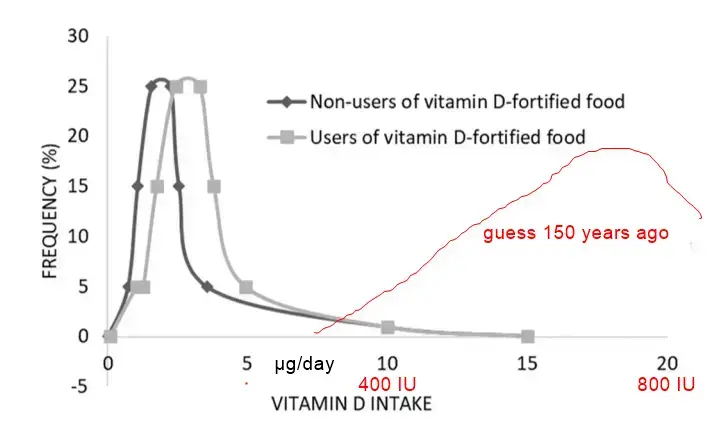Europeans now get 200 IU of Vitamin D daily (had been 600 IU)
Contribution of different vitamin D forms and fortified foods to vitamin D intake in Europe: a narrative review
J Steroid Biochem Mol Biol. 2025 Apr 14:106761. doi: 10.1016/j.jsbmb.2025.106761
Maaike J Bruins 1

In the current narrative review, the bioavailability of the main vitamin D forms is evaluated. The mean intakes and main contributing forms of vitamin D in the European diet are estimated, as well as the major contributing dietary sources. The literature is reviewed for studies reporting on the proportion of users and non-users of fortified food with vitamin D intakes below reference intakes. In addition, the availability of vitamin D-fortified prepackaged retail products and fortification levels in the European market is assessed. Previously, vitamins D2 and D3 forms were considered the primary forms in the diet. Recent analytical methods suggest that dietary 25(OH)D3, when adjusted for higher bioequivalence, significantly contributes to total vitamin D intakes. When also considering 25(OH)D3 from foods, the estimated vitamin D intake from an average European diet was 3.8µg/d of total Vitamin D Equivalents: vitamin D3, vitamin D2 and 25(OH)D3, contributing about 71%, 2%, and 27%, respectively. Animal foods, fortified fats and spreads contributed most to total intakes.
Literature suggests that 94-100% of Europeans aged ≥ 13y fail to meet the vitamin D reference intake of 10µg/d,
About 98-100% of vitamin D-fortified food users and
99-100% of non-users in the UK and Netherlands consumed less than 10µg/d of vitamin D.
About 1.2% of prepackaged foods and drinks were voluntary fortified with vitamin D, margarine and plant-based drinks providing most of the daily vitamin D. Encouraging fortification and other strategies may support closing the gap between current and recommended vitamin D intakes.
📄 Download the PDF from VitaminDWiki .
European diet 150 years ago provided 600-1000 IU of Vitamin D daily
Pre-processed form provides 6X equivalent Vitamin D than non-preprocessed vitamin D
pork, lard, chicken, eggs, eels, liver, kidneys, herring, mackerel, sardines, etc.
📄 Report by Perplexity AI or click here for online
{MOUSEOVER(label="Hover here to see question" offsetx="4" offsety="15")} I would like to get an estimate about how much vitamin D the average European got from food daily 150 years ago. Food used to contain a LOT more vitamin D. Examples: pigs, chicken, eels, liver, kidneys, small fatty fish, sardines, tripe, eggs. Note: many animal products contain a lot more semi-activated vitamin D, than regular vitamin D{MOUSEOVER}
Example: A slice of pie made with lard from pigs raised outdoor contained 2,000 IU
see: Does Less Sun mean More Disease 5 minute video by VitaminDWiki
see: "Free range" lard has 500 IU vitamin D per teaspoon
Industrial food production removed about 400 IU, Fortification replaces about 120 IU

VitaminDWiki - 43 reasons for Vitamin D deficiency
LESS : sun, free-roaming farm animals, wild fish and game, organ meats, magnesium
MORE : obesity, pesticides, smoke, air polution, drugs, Omega-6
VitaminDWiki - Deficiency in Europe studies
This list is automatically updated
{category}
VitaminDWiki – Overview Deficiency of vitamin D contains
{include}
